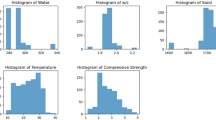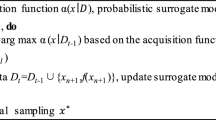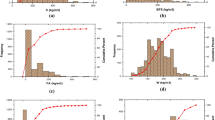Abstract
Because of the ever-increasing demand for lightweight concrete (LC), especially in structural applications where it is used to reduce dead load of the structure and construction costs while contributing to environmental protection thanks to decreased use of aggregates and cement, presenting optimal mixing design for preparing structural LC (SLC) is of paramount importance. In this article, application of artificial neural networks in predicting the compressive strength of SLC was investigated. For this purpose, we used some pattern recognition neural network and genetic expression programming (GEP) with experimental data from tests to predict the compressive strength of SLC. A total of 10 input parameters from the SLC mix design were utilized for predicting the compressive strength by means of a scaled conjugate gradient backpropagation algorithm in the form of a neural network. The outputs were classified into 5 strength groups of M1, M2, M3, M4 and M5. The simulation results were 98.8% accurate in classifying SLC samples under different predefined ranges of compressive strength using the confusion matrix diagram. Moreover, the cross-entropy error obtained from testing the neural network (NN) model and correlation coefficient (R2) of GEP for predicting compressive strength of the SLC were evaluated at 0.0076082 and 0.9912, respectively, indicating high accuracy of the model. Application of this model could greatly help relevant practitioners formulate SLCs with desired compressive strength.








Similar content being viewed by others
References
Al-Rashed, R.; Al-Jabari, M.: Concrete protection by combined hygroscopic and hydrophilic crystallization waterproofing applied to fresh concrete. Case Stud. Construct. Mater. 15, 1–11 (2021). https://doi.org/10.1016/j.cscm.2021.e00635
Amiri, M.; Hatami, F.; Golafshani, E.: Evaluating the synergic effect of waste rubber powder and recycled concrete aggregate on mechanical properties and durability of concrete. Case Stud. Construct. Mater. 15, 1–10 (2021). https://doi.org/10.1016/j.cscm.2021.e00639
Evram, A., et al.: Effects of waste electronic plastic and marble dust on hardened properties of high strength concrete. Constr. Build. Mater. 263, 1–10 (2020). https://doi.org/10.1016/j.conbuildmat.2020.120928
Ibrahim, K.I.M.: Recycled waste glass powder as a partial replacement of cement in concrete containing silica fume and fly ash. Case Stud. Construct. Mater. 15, 1–10 (2021). https://doi.org/10.1016/j.cscm.2021.e00630
Mehta, P.K.; Monteiro, P.J.M.: Concrete: Microstructure, Properties, and Materials, 4th edn. McGraw-Hill, New York (2014)
A.C. Institute.: Guide for Structural Lightweight-Aggregate Concrete. ACI 213R-14. ACI Committee, (2014).
A.C. Institute.: Standard Specification for Lightweight Aggregates for Structural Concrete. ACI C330/C330M-14. ACI Committee, (2017).
Kou, G.; Xiao, H.; Cao, M.; Hay Lee, L.: Optimal computing budget allocation for the vector evaluated genetic algorithm in multi-objective simulation optimization. Automatica 129, 1–14 (2021). https://doi.org/10.1016/j.automatica.2021.109599
Kou, G.; Yi, K.; Xiao, H.; Cao, M.; Peng, R.: Reliability of a distributed data storage system considering the external impacts. IEEE Trans. Reliab. 2022, 1–10 (2022). https://doi.org/10.1109/TR.2022.3161638
Xiao, H.; Yan, Y.; Kou, G.; Wu, S.: Optimal inspection policy for a single-unit system considering two failure modes and production wait time. IEEE Trans. Reliab. 2021, 1–13 (2021). https://doi.org/10.1109/TR.2021.3125963
Iftikhar, B., et al.: Predictive modeling of compressive strength of sustainable rice husk ash concrete: ensemble learner optimization and comparison. J. Clean. Prod. 348, 1–10 (2022). https://doi.org/10.1016/j.jclepro.2022.131285
SamiUllaha, H., et al.: Predictive modelling of sustainable lightweight foamed concrete using machine learning novel approach. Journal of Building Engineering. 56, 1–10 (2022). https://doi.org/10.1016/j.jobe.2022.104746
Ahmad, A., et al.: Compressive strength prediction of fly ash-based geopolymer concrete via advanced machine learning techniques. Case Stud. Construct. Mater. 16, 1–16 (2022). https://doi.org/10.1016/j.cscm.2021.e00840
AliKhan, M., et al.: Application of gene expression programming (GEP) for the prediction of compressive strength of geopolymer concrete. Materials 14(5), 1–21 (2021). https://doi.org/10.3390/ma14051106
Yan, C., et al.: A review study of application of artificial intelligence in construction management and composite beams. Steel Compos. Struct. 36(6), 685–700 (2021). https://doi.org/10.12989/scs.2021.39.6.685
Farooq, F., et al.: Predictive modeling for sustainable high-performance concrete from industrial wastes: a comparison and optimization of models using ensemble learners. J. Clean. Prod. 292, 1–10 (2021). https://doi.org/10.1016/j.jclepro.2021.126032
Majeed, S.S., et al.: Properties of self-compacted concrete incorporating basalt fibers: Experimental study and Gene Expression Programming (GEP) analysis. Comput. Concrete 28(5), 451–463 (2021). https://doi.org/10.12989/cac.2021.28.5.451
Shishegaran, A., et al.: High correlated variables creator machine: prediction of the compressive strength of concrete. Comput. Struct. 247, 1–10 (2021). https://doi.org/10.1016/j.compstruc.2021.106479
AliKhan, M., et al.: Compressive strength of fly-ash-based geopolymer concrete by gene expression programming and random forest. Adv. Civil Eng. 2021, 1–17 (2021). https://doi.org/10.1155/2021/6618407
Ahmad, A., et al.: Prediction of compressive strength of fly ash based concrete using individual and ensemble algorithm. Materials 14(4), 1–21 (2021). https://doi.org/10.3390/ma14040794
Shahmansouri, A.A., et al.: Compressive strength prediction of eco-efficient GGBS-based geopolymer concrete using GEP method. J. Build. Eng.. 31, 1–11 (2020). https://doi.org/10.1016/j.jobe.2020.101326
Javed, M.F., et al.: Applications of gene expression programming and regression techniques for estimating compressive strength of bagasse ash based concrete. Crystals 10(9), 1–17 (2020). https://doi.org/10.3390/cryst10090737
Shariati, M., et al.: Prediction of concrete strength in presence of furnace slag and fly ash using Hybrid ANN-GA (Artificial Neural Network-Genetic Algorithm). Smart Struct. Syst. 25(2), 183–195 (2020). https://doi.org/10.12989/sss.2020.25.2.183
Aslam, F., et al.: Applications of gene expression programming for estimating compressive strength of high-strength concrete. Adv. Civil Eng. 2020, 1–23 (2020). https://doi.org/10.1155/2020/8850535
Farooq, F., et al.: A comparative study of random forest and genetic engineering programming for the prediction of compressive strength of high strength concrete (HSC). Appl. Sci. 10(20), 1–18 (2020). https://doi.org/10.3390/app10207330
Nematzadeh, M., et al.: Post-fire compressive strength of recycled PET aggregate concrete reinforced with steel fibers: optimization and prediction via RSM and GEP. Constr. Build. Mater. 252, 1–10 (2020). https://doi.org/10.1016/j.conbuildmat.2020.119057
Shahmansouri, A.A., et al.: Predicting compressive strength and electrical resistivity of eco-friendly concrete containing natural zeolite via GEP algorithm. Constr. Build. Mater. 229, 1–10 (2019). https://doi.org/10.1016/j.conbuildmat.2019.116883
Alkroosh, I.S.; Sarker, P.K.: Prediction of the compressive strength of fly ash geopolymer concrete using gene expression programming. Comput. Concrete 24(4), 295–302 (2019). https://doi.org/10.12989/cac.2019.24.4.295
Asteris, P.G.; Kolovos, K.G.: Self-compacting concrete strength prediction using surrogate models. Neural Comput. Appl. 31, 409–424 (2019). https://doi.org/10.1007/s00521-017-3007-7
Asteris, P.G., et al.: Application of artificial neural networks for the prediction of the compressive strength of cement-based mortars. Comput. Concrete 24(4), 329–345 (2019). https://doi.org/10.12989/cac.2019.24.4.329
Tsai, H.C.; Liao, M.C.: Knowledge-based learning for modeling concrete compressive strength using genetic programming. Comput. Concrete 23(4), 255–265 (2019). https://doi.org/10.12989/cac.2019.23.4.255
Dao, D.V., et al.: Artificial intelligence approaches for prediction of compressive strength of geopolymer concrete. Materials. 12(6), 1–17 (2019). https://doi.org/10.3390/ma12060983
Vakhshouri, B.; Nejadi, S.: Prediction of compressive strength of self-compacting concrete by ANFIS models. Neurocomputing 280, 1–11 (2018). https://doi.org/10.1016/j.neucom.2017.09.099
Onyari, E.K.; Ikotun, B.D.: Prediction of compressive and flexural strengths of a modified zeolite additive mortar using artificial neural network. Constr. Build. Mater. 187, 1232–1241 (2018). https://doi.org/10.1016/j.conbuildmat.2018.08.079
Getahun, M.A., et al.: Artificial neural network based modelling approach for strength prediction of concrete incorporating agricultural and construction wastes. Constr. Build. Mater. 190, 517–525 (2018). https://doi.org/10.1016/j.conbuildmat.2018.09.097
Sadrossadat, E., et al.: Numerical formulation of confined compressive strength and strain of circular reinforced concrete columns using gene expression programming approach. Struct. Concr. 19(3), 783–794 (2018). https://doi.org/10.1002/suco.201700131
Azimi-Pour, M.; Eskandari-Naddaf, H.: ANN and GEP prediction for simultaneous effect of nano and micro silica on the compressive and flexural strength of cement mortar. Constr. Build. Mater. 189, 978–992 (2018). https://doi.org/10.1016/j.conbuildmat.2018.09.031
Reddy, T.C.S.: Predicting the strength properties of slurry infiltrated fibrous concrete using artificial neural network. Front. Struct. Civ. Eng. 12, 490–503 (2018). https://doi.org/10.1007/s11709-017-0445-3
Belalia Douma, O., et al.: Prediction of properties of self-compacting concrete containing fly ash using artificial neural network. Neural Comput. Appl. 28, 707–718 (2017). https://doi.org/10.1007/s00521-016-2368-7
Saha, P.; Kumar, P.R.: Predicting strength of SCC using artificial neural network and multivariable regression analysis. Comput. Concrete 20(1), 31–38 (2017). https://doi.org/10.12989/cac.2017.20.1.031
Khademi, F., et al.: Multiple linear regression, artificial neural network, and fuzzy logic prediction of 28 days compressive strength of concrete. Front. Struct. Civ. Eng. 11, 90–99 (2017). https://doi.org/10.1007/s11709-016-0363-9
Eskandari-Naddaf, H.; Kazemi, R.: ANN prediction of cement mortar compressive strength. Influence of cement strength class. Construct. Build. Mater. 138, 1–11 (2017). https://doi.org/10.1016/j.conbuildmat.2017.01.132
Abu Yaman, M., et al.: Predicting the ingredients of self compacting concrete using artificial neural network. Alexandria Eng. J. 56(4), 523–532 (2017). https://doi.org/10.1016/j.aej.2017.04.007
Moller, M.F.: A scaled conjugate gradient algorithm for fast supervised learning. Neural Netw. 6(4), 525–533 (1993). https://doi.org/10.1016/S0893-6080(05)80056-5
A.C. Institute.: Standard Specification for Portland Cement. ACI C150/C150M-22. ACI Committee, (2022).
A.C. Institute.: Standard Specification for Blended Hydraulic Cements. ACI C595/C595M-21. ACI Committee, (2022).
A.C. Institute.: Standard Specification for Coal Fly Ash and Raw or Calcined Natural Pozzolan for Use in Concrete. ACI C618–22. ACI Committee, (2022).
A.C. Institute.: Standard Performance Specification for Hydraulic Cement. ACI C1157/C1157M-20a. ACI Committee, (2021).
Hajihassani, M., et al.: A gene expression programming model for predicting tunnel convergence. Appl. Sci. 9, 1–22 (2019). https://doi.org/10.3390/app9214650
Mansouri, I.; Hu, J.W.; Kisi, O.: Novel predictive model of the debonding strength for masonry members retrofitted with FRP. Appl. Sci. 6, 1–13 (2016). https://doi.org/10.3390/app6110337
Ferreira, C.: Gene expression programming: a new adaptive algorithm for solving problems. Complex Syst. 13, 87–129 (2001)
Ferreira, C.: Gene Expression Programming: Mathematical Modeling by an Artificial Intelligence. Springer, Netherlands (2006)
Azim, I., et al.: Prediction model for compressive arch action capacity of RC frame structures under column removal scenario using gene expression programming. Structures 25, 212–228 (2020). https://doi.org/10.1016/j.istruc.2020.02.028
Gepsoft.: Gene Expression Programming (GEP). Viewed 1 Dec 2020, http://www.gepsoft.com/, (2020).
Acknowledgements
The authors would like to thank the respected CEO of Ravagh Sazan Ostovar Co. for his cooperation and provision of laboratory facilities for performing the tests and numerical studies.
Author information
Authors and Affiliations
Corresponding author
Ethics declarations
Conflict of interest
The authors report no conflicts of interest.
Rights and permissions
Springer Nature or its licensor (e.g. a society or other partner) holds exclusive rights to this article under a publishing agreement with the author(s) or other rightsholder(s); author self-archiving of the accepted manuscript version of this article is solely governed by the terms of such publishing agreement and applicable law.
About this article
Cite this article
Hosseini, S.A., Maleki Toulabi, H. Presenting a Novel Approach for Predicting the Compressive Strength of Structural Lightweight Concrete Based on Pattern Recognition and Gene Expression Programming. Arab J Sci Eng 48, 14169–14181 (2023). https://doi.org/10.1007/s13369-023-07996-2
Received:
Accepted:
Published:
Issue Date:
DOI: https://doi.org/10.1007/s13369-023-07996-2




